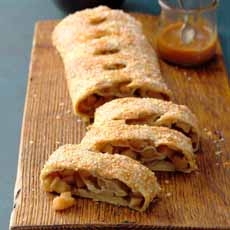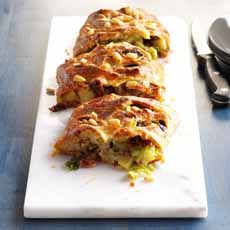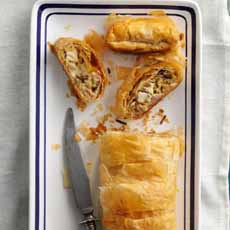FOOD HOLIDAY: Make Some Strudel For National Strudel Day
|
June 17th is National Strudel Day. While most people tend to think “apple strudel,” strudels can be sweet or savory. While seasonal fruits are popular fillings, some sweet strudels are fruit-free, filled instead with soft, sweetened cheese (quark), poppy seeds, or nuts. Savory strudels are filled with cheeses, meats, seafood, or vegetables. We have some great recipes for your perusal, below. While sweet strudels are served as a breakfast pastry, a nibble with a cup of tea or coffee, or dessert, savory strudels are served as a luncheon main with a salad, or as a first course with dinner. Check out the strudel recipes below. Strudel is an Austro-Hungarian pastry made with a thin, layered dough. Originally that dough was the almost-transparent sheets of Turkish phyllo. Subsequent cultures employed the much-easier-to-use puff pastry (see the difference below). The recipe for baklava is said to date to the Assyrian court in the 8th century B.C.E. The tissue-thin phyllo dough we know today was probably developed by the Ottoman Sultan’s chefs in the Topkapi Palace in 15th-century Constantinople. The idea was, “the thinner the better.” One chef instructed that the sheets be so transparent, that one should be able to read a love letter through them. The oldest written strudel recipes date from 1696. They include a sweet, milk cream-filled strudel (like pastry cream), and a savory turnip strudel (source). Food historians believe that the Turkish baklava pastry, made from phyllo, was introduced into the Hapsburg/Austrian Empire around the 15th century* (some sources say as late as the 17th century). It, and the baklava that was made from it, served as the evolution point for strudel. In Hungary, the chopped nuts and honey filling of baklava was adapted to different flavors, including dried fruits like raisins, and jams‡ (source). Puff pastry was substituted for phyllo. Soon after Hungary became part of the Austrian Empire in 1699, these rolled puff pastries arrived in Vienna, where they were called strudel. The word strudel (STROO-dull) derives from the German word Strudel, which means “whirlpool” or “eddy” in Middle High German. The image comes from rolling the dough in concentric circles. Toward the close of the Ottoman-Hapsburg Wars† in the 18th-century Hapsburg Empire, strudels became popular in Hapsburg Monarchy/Austrian Empire, the capitals of which were variously Vienna and Prague. From 1800 onwards recipes were created incorporating every type of ingredient. |
|
|
|
Strudel is one of the national dishes of Austria; and oddly, it’s the official state pastry of Texas (along with the sopaipilla). STRUDEL RECIPES Savory Strudels Two doughs are very different. Per Taste Of Home: *We have found the “official” date of 1453, but this seems wrong. This is the date that the Ottomans captured Byzantium, an ancient Greek colony that later became Constantinople, and then Istanbul. †The Ottoman–Habsburg wars, from the 16th century through the 18th century, were fought by the Ottoman Empire (modern Turkey) and the Habsburg Monarchy (Austria, Czechoslovakia, Hungary, and other areas). In the early modern period in Europe, Ottoman Turkey was arguably the strongest military and political power. The Ottoman Sultan ruled an Empire from Persia to Central Europe. It is widely accepted that if the Muslims Empire had been successful at the Battle or Siege of Vienna in 1683 that it could have gone on and dominated Europe and changed not only European history but also world history (source). During this time, different Turkish influences were introduced to Europe. ‡The same approach was used to make rugelach.
|
||



